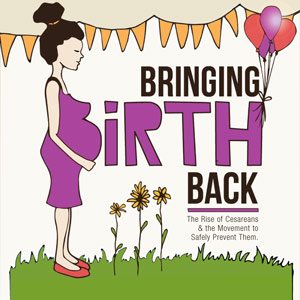Infographic – Bringing Birth Back

The Rise of Cesareans
Historically, cesareans were a last resort to be used only when a mother was beyond help in order to save the baby. The death rate was 100%. Today, while they have saved countless mothers and babies, they are so commonplace that they comprise 1 in 3 births (32.8%) [1,296,070 out of 3,952,841 births – 2012]. The World Health Organization stands by its claim that only 10 – 15% of births are justified by a cesarean.
Members of the medical community, armed with new research and standards, are helping families to bring birth back!
Cesarean Rates
| 1970: 5.5% | 1991: 22.6% | 2002: 26.1% |
| 1975: 10.4 | 1992: 22.3% | 2003: 27.5% |
| 1980: 16.5 | 1993: 21.8% | 2004: 29.1% |
| 1983: 20.3% | 1994: 21.2% | 2005: 30.3% |
| 1984: 21.1% | 1995: 20.8% | 2006: 31.3% |
| 1985: 22.7% | 1996: 20.7% | 2007: 32.0% |
| 1986: 24.1% | 1997: 20.8% | 2008: 32.3% |
| 1987: 24.4% | 1998: 21.2% | 2009: 32.9% |
| 1988: 24.7% | 1999: 22.0% | 2010: 32.8% |
| 1989: 23.8% | 2000: 22.9% | 2011: 32.8% |
| 1990: 22.7% | 2001: 24.4% | 2012: 32.8% |
Why Does it Matter?
Because cesarean sections are considered to be major surgery and with that comes risk.
Risks for mom
- The death rate is over 3.5x higher for cesareans: 13.3 per 100,000 women (low-risk planned cesarean) vs. 3.6 per 100,000 women delivering vaginally
- The complication rate is over 2x higher for cesareans: 9.5% for cesareans vs. 4.5% for vaginal.
- General surgical risks – infection, injury to organs, serious bleeding
- Chronic pelvic pain
- More difficult recovery
Risks for baby
- Respiratory problems: 1.0 – 4.0% when Caesarean is performed without labor vs. <1.0% when baby is delivered vaginally
- Childhood disease like asthma and diabetes
How Did We Get Here?
Cesarean benefits
- It’s the only safe option for babies positioned in the transverse lie (baby is laying sideways, perpendicular to mother)
- It’s the only safe option when placenta is covering the cervix
- in some situations (i.e. changes in fetal heart rhythm which might indicate low oxygen levels) a physician and mother might decide the benefits outweigh the risks and proceed with a cesarean
Reasons women had their first cesarian:
- 34%: Labor arrest: absence of progress of active labor (as defined by cervical dilation and descent of the presenting part) for 2 hours or longer.
- 23%: Nonreassuring fetal heart rate tracing (heart rate too fast, too slow, abnormal)
- 17%: Malpresentation (i.e. breech presentation [breech], shoulder presentation [transverse lie]) – only 3.7% of births are breech, 2.2% are transverse, 94.1% are Cephalic.
- 7%: Multiple gestation (twins triplets etc..)
- 5%: Maternal-fetal conditions (i.e. gestational diabetes, infection, and other high-risk conditions)
- 4%: Macrosomia (babies with birth weight of 8 pounds, 13 ounces or larger)
- 3%: Preeclampsia (multi-symptom disorder characterized by high blood pressure and high levels of protein in the urine)
- 3%: Maternal request
- 4%: Other obstetric indications
However, the World Health Organization claims only 10 – 15% of births are justified by a cesarean. In 2012, 32.8% of births were cesarean. In other words, it’s overused.
There are several contributing factors to and evidence of overuse.
Variations in Cesarean Practice
Cesarean rates by state in 2012 [2]
| AL – 35.5% | IL – 31.9% | MT – 31.2% | RI – 31.6% |
| AK – 23.4% | IN – 30.7% | NE – 31.5% | SC – 35.4% |
| AZ – 27.2% | IA – 30.8% | NV – 35.0% | SD – 25.4% |
| AR – 34.9% | KS – 30.2% | NH – 30.8% | TN – 33.8% |
| CA – 33.2% | KY – 36.2% | NJ – 38.7% | TX – 35.3% |
| CO – 25.9% | LA – 40.2% | NM – 23.9% | UT – 22.6% |
| CT – 34.8% | ME – 30.5% | NY – 34.2% | VT – 27.1% |
| DE – 33.1% | MD – 35.0% | NC – 30.6% | VA – 34.3% |
| DC – 33.6% | MA – 31.7% | ND – 28.5% | WA – 29.0% |
| FL – 38.1% | MI – 32.6% | OH – 30.9% | WV – 35.9% |
| GA – 33.8% | MN – 27.0% | OK – 33.8% | WI – 26.3% |
| HI – 25.1% | MS – 38.1% | OR – 28.3% | WY – 29.2% |
| ID – 24.9% | MO – 31.8% | PA – 31.5% |
Hospitals have a cesarean rate range from 7% – 70%!!
Maternal characteristics, such as age, weight, and ethnicity, have consistently been found not to account for the increase cesarean rate or its regional variations.
Payout system favors cesareans:
Average facility birth charges in 2010
- Birth Center – vaginal $2,277
- Hospital – vaginal w/ no complications $10,166
- Hospital – vaginal w/ complications $13,170
- Hospital – cesarean w/ no complications $17,052
- Hospital – cesarean w/ complications $23,111
Fear of malpractice suits:
- 90% of OBGYNs have been sued in their career.
- 29% of OBGYNs admit to increasing cesarean births because of the risk of liability claims.
- Many hospitals and practitioners do not allow women to have VBACs, which raises the cesarean rate.
VBAC Rates
VBAC rates – percent of births after cesareans performed vaginally
| 1970: 2.2% | 1995: 27.5% | 2005: 10.1% |
| 1975: 2.0% | 1996: 28.3% | 2006: 8.5% |
| 1980: 3.4% | 1997: 27.4% | 2007: 8.3% |
| 1985: 6.6% | 1998: 26.3% | 2008: 8.4% |
| 1989: 18.9% | 1999: 23.4% | 2009: 8.4% |
| 1990: 19.9% | 2000: 20.6% | 2010: 9.2% |
| 1991: 21.3% | 2001: 16.4% | 2011: 9.7% |
| 1992: 22.6% | 2002: 12.6% | 2012: 10.2% |
| 1993: 24.3% | 2003: 10.6% | |
| 1994: 26.3% | 2004: 9.2% |
Convenience for doctors and moms:
- an estimated 4-18% of mothers request a cesarean
- only 28% of mothers who had a cesarean tried to deliver naturally.
- 10% of births are early schedule births for non medical reasons
- scheduling cesareans allows more patients, which increases income
- 60% of birth are during business hour
Where Do We Go From Here?
“This is a game-changer.” [in reference to the March 2014 recommendations released by ACOG] Michele Ondeck, president of Lamaze International
In March 2014, the American College of Obstetricians and Gynecologists (ACOG) recommended changes in practice: [5]
1. Allow more time for labor
- First stage-early:
- Extend early first stage of labor up to 6cm dilation (instead of 4)
- No time limit (instead of 20hr [first birth] and 14hrs [2nd+births])
- allowing oxytocin be administered for at least 12–18 hours after membrane rupture before deeming the induction a failure.
- If labor is induced (22.8% of the time), use cervical ripening methods (such as misoprostol, dinoprostone, prostaglandin E2 gel, Foley bulbs, and laminaria tents)
- First stage-active: Labor arrest should not be diagnosed except for mothers who fail to progress…
- with ruptured membranes
- at least 6+cm dilated (instead of 4cm)
- at least 4 hours of adequate contractions (instead of 2hr).
- Second stage:
- No maximum time length.
- Labor arrest should not be diagnosed during second stage until at least 3 hours of pushing (instead of 2hr) [first birth] and 2 hours (instead of 1hr) [second+ birth].
2. Apply external pressure to turn babies in breech position
- Apply external pressure to turn babies in breech position (
- More than half can successfully be turned and delivered vaginally. Cesarean should only be considered if this fails
- manually rotate babies in head down but undesirable position (Occiput posterior [‘sunny-side-up]). Mothers who rotate their babies have 9% chance of a cesarean birth compared to 41% who don’t manually rotate.
3. Interpret and stabilize the fetal heart rate
- Amnioinfusion: infusing normal saline into the uterine cavity can stabilize abnormal fetal heart rate.
- Scalp stimulation can be used to determine if a cesarean in necessary when heart rate abnormalities are present.
4. “Big babies” have to be much bigger to validate a cesarean!
- At least 9 pounds, 14 ounces in women with diabetes
- At least 11 pounds in women without diabetes
- Weight measurements late in the pregnancy can be imprecise
5. Operative vaginal delivery (forceps or vacuum) is a great alternative!
- At the completion of their training, 55% of resident physicians did not feel competent to perform a forceps delivery. Physicians need to be trained again!
- Fewer than 3% of women in whom an operative vaginal delivery has been attempted go on to deliver by cesarean
- There is no difference in forceps, vacuum or cesarean in term of neonatal morbidity rates.
Percentage of all births that use forceps or vacuum:
| 1990: 9.0% | 2005: 4.8% | 2010: 3.6% |
| 1995: 9.4% | 2008: 3.9% | 2011: 3.5% |
| 2000: 6.9% | 2009: 3.7% | 2012: 3.4% |
6. Induction Timing
- Before 41 0/7 weeks gestation – should only be performed if there are medical indications
- Beyond 41 0/7 weeks gestation – should be performed to reduce the risk of cesarean delivery
Less Restrictive Guidelines
In 2010, ACOG also released less restrictive guidelines regarding VBACs.
- Most women who have had a low transverse caesarean can qualify to attempt a VBAC, and should be allowed to do so
- 60 – 80% of women who attempt will be successful
ACOG also claims that “continuous labor support” should be the norm rather than the exception in order to decrease the cesarean rate and improve the birth experience for women.
Effects of continuous labor support compared to usual care, measured by “risk ratios” (RR) [13]
[Risk Ratio (RR) – the risk of an event for women receiving continuous support divided by the risk for women receiving usual care. A value of one implies that continuous support had no effect; less than one that the support reduced the risk of the event; more than one that the occurrence of the event increased.]
- Spontaneous vaginal birth: 1.08 RR
- Intrapartum analgesia (any type of anesthesia during labor): 0.90 RR
- Dissatisfaction: 0.69 RR
- Shorter labors: -0.58 hours
- Caesarean: 0.78 RR
- Instrumental vaginal birth (vacuum or forceps-assisted birth): 0.90 RR
- Regional analgesia (epidural or spinal block): 0.93 RR
- Baby with a low five-minute APGAR score: 0.69 RR [Appearance (skin color), Pulse (heart rate), Grimace (reflex irritability), Activity (muscle tone), and Respiration] – 1-10 scale test given 5 minutes after birth.
The support was most effective when it was someone who was neither a member of the hospital staff nor a member of the woman’s social network (like a doula).
What’s a Doula?
Umm… what’s a doula? [14]
- “doula” comes from ancient Greek meaning “a woman who serves”
- from DONA.org: “a trained and experienced professional who provides continuous physical, emotional and informational support to the mother before, during and just after birth; or who provides emotional and practical support during the postpartum period”
Two types:
- Birth Doula
- helps woman prepare and carry out her birth plans
- aims to nurture and protect the woman’s birth experience
- present with the woman throughout labor
- provides emotional support, physical comfort measures and an objective viewpoint
- facilitates communication between laboring woman, her partner and care providers
- Postpartum Doula
- helps with newborn care, family adjustment, meal prep and some household chores
- offers education and support on infant feeding and soothing, as well as emotional and physical recovery from birth
What Can You Do?
- Talk with your physician about your options and find out about their protocols.
- If you’ve had a cesarean previously, find a practitioner and hospital allowing VBACs and work with them to see if you’re a candidate.
www.ican-online.org for more info and database
- Consider a midwife and birthing center for your pregnancy and birth.
https://ourmomentoftruth.com for more info and database
- Hire a doula.
www.dona.org for more info and database
- Take control of your birth! Develop a birth plan in advance.
https://americanpregnancy.org for more info
https://www.earthmamaangelbaby.com/free-birth-plan – tool to create your own custom plan

Sources:
- https://www.cdc.gov/nchs/data/nvsr/nvsr60/nvsr60_01.pdf
- https://www.cdc.gov/nchs/data/nvsr/nvsr62/nvsr62_09_tables.pdf
- https://www.cdc.gov/nchs/data/nvsr/nvsr47/nvs47_18.pdf
- https://www.cdc.gov/mmwr/preview/mmwrhtml/00036845.htm
- https://www.weikert.de/alexandra/who1.html
- https://www.cdc.gov/nchs/data/nvsr/nvsr62/nvsr62_09.pdf
- ftp://ftp.cdc.gov/pub/Health_Statistics/NCHS/Dataset_Documentation/DVS/natality/UserGuide2012.pdf
- https://www.dona.org/mothers/
- https://www.usatoday.com/story/news/nation/2014/02/19/reducing-cesarean-sections/5608139/
- https://www.ncbi.nlm.nih.gov/pmc/articles/PMC3615450/
Related:





